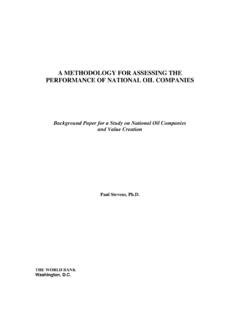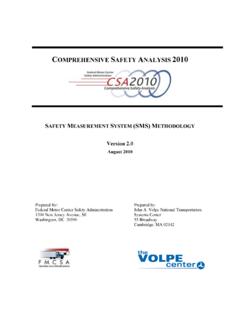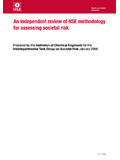Transcription of Assessing climate change vulnerability in sheries …
1 FAO. ISSN 2070-7010. FISHERIES AND. AQUACULTURE. TECHNICAL. PAPER. 597. Assessing climate change vulnerability in fisheries and aquaculture Available methodologies and their relevance for the sector Cover photo credits: All photos: FAO, except bottom right: Ganges River Delta, Bangladesh, Source: NASA. Assessing climate change FAO. FISHERIES AND. AQUACULTURE. vulnerability in fisheries and TECHNICAL. PAPER. aquaculture 597. Available methodologies and their relevance for the sector Cecile Brug re FAO Consultant Rome, Italy and Cassandra De Young Policy and Economics Division FAO Fisheries and Aquaculture Department Rome, Italy FOOD AND AGRICULTURE ORGANIZATION OF THE UNITED NATIONS. Rome, 2015. The designations employed and the presentation of material in this information product do not imply the expression of any opinion whatsoever on the part of the Food and Agriculture Organization of the United Nations (FAO) concerning the legal or development status of any country, territory, city or area or of its authorities, or concerning the delimitation of its frontiers or boundaries.
2 The mention of specific companies or products of manufacturers, whether or not these have been patented, does not imply that these have been endorsed or recommended by FAO in preference to others of a similar nature that are not mentioned. The views expressed in this information product are those of the author(s) and do not necessarily reflect the views or policies of FAO. ISBN 978-92-5-108946-0. FAO, 2015. FAO encourages the use, reproduction and dissemination of material in this information product. Except where otherwise indicated, material may be copied, downloaded and printed for private study, research and teaching purposes, or for use in non-commercial products or services, provided that appropriate acknowledgement of FAO as the source and copyright holder is given and that FAO's endorsement of users' views, products or services is not implied in any way.
3 All requests for translation and adaptation rights, and for resale and other commercial use rights should be made via or addressed to FAO information products are available on the FAO website ( ) and can be purchased through iii Preparation of this document This Technical Paper was prepared under the auspices of two projects: Fisheries management and marine conservation within a changing ecosystem context (GCP/. INT/253/JPN) , supported by the Government of Japan, and climate change , Fisheries and Aquaculture: testing a suite of methods for understanding vulnerability , improving adaptability and enabling mitigation (GCP/GLO/322/NOR) supported by the Government of Norway. An earlier version served as a background document for the global Expert Workshop on Assessing climate change vulnerability in Fisheries and Aquaculture: Available Methodologies and their Relevance for the Sector, which was convened by the FAO.
4 Fisheries and Aquaculture Department climate change Working Group and the Global Partnership on climate , Fisheries and Aquaculture (PaCFA) in Windhoek, Namibia, from 8 to 10 April 2013, and hosted by the Benguela Current Commission. It benefited from the constructive comments received from PaCFA members, and in particular those of Prof James Muir, to whose memory this publication is dedicated. Outcomes of the discussions and feedback provided by participants at the Windhoek Expert Workshop have been incorporated in the present publication. iv Abstract From relatively limited and narrow uses two decades ago, the concept of vulnerability has emerged as a key dimension of the development debate. Be it in relation to climate change , disasters, globalization and economic development, and social ecological system changes more generally, vulnerability is a complex and multifaceted concept that has attracted the attention of scholars and development practitioners from all disciplines.
5 The many interpretations of vulnerability and its many scales ( individual, community, ecosystem, countries, continents) and fields of application have led to a wide array of propositions regarding ways and means by which vulnerability could be studied, characterized, understood, and acted upon. This multiplication of approaches and methodologies of assessment has enabled new insights into the causes and consequences of vulnerability , but has also caused some confusion among practitioners and led to the voicing of a need for clarification and guidance on how best to approach the study of vulnerability . This publication provides an overview of vulnerability assessment concepts and methodologies. It sheds light on the different vulnerability assessment methodologies that have been developed, and on how these are conditioned by the disciplinary traditions from which they have emerged.
6 It also analyses how these methodologies have been applied in the context of fisheries and aquaculture, with illustrative examples of their application. A series of practical steps to assess vulnerability in the fisheries and aquaculture sector is proposed in order to support climate change specialists working with communities dependent on fisheries and aquaculture, as well as fisheries and aquaculture practitioners wishing to incorporate adaptation planning into the sector's management and development. FAO. 2015. Assessing climate change vulnerability in fisheries and aquaculture: Available methodologies and their relevance for the sector, by Cecile Brug re and Cassandra De Young. FAO Fisheries and Aquaculture Technical Paper No.
7 597. Rome, Italy. v Contents Preparation of this document iii Abstract iv Acknowledgements vii Abbreviations and acronyms viii 1. Introduction 1. Why a vulnerability assessment 1. vulnerability in fisheries and aquaculture 2. 2. Understanding vulnerability : clarifying concepts and perspectives 5. Describing and understanding vulnerability 5. vulnerability in fisheries and aquaculture 2. The IPCC model of vulnerability 8. Links to other concepts and frameworks 10. Resilience 10. Sustainable livelihoods 11. Institutional analysis and development framework 11. Hyogo Framework for Action 11. Ecosystem approach to fisheries/aquaculture (EAF/EAA) 12. 3. Capturing and measuring vulnerability : available methodologies for vulnerability assessments 15.
8 Classification of methodologies for vulnerability assessments 15. Top-down/quantitative methodologies 15. Bottom-up/qualitative methodologies 16. Integrative methodologies 16. Methodological issues 20. Data availability and confidence 20. vulnerability measures, indicators and indices 21. Identification of winners and losers and scale issues 24. Communicating results of vulnerability assessments 24. Good practices and principles for vulnerability assessments 24. 4. vulnerability assessments in fisheries and aquaculture 27. Overview of the application of vulnerability assessments in aquatic and land-based systems 27. Examples of vulnerability assessments in fisheries and aquaculture 29. Case study 1 vulnerability of national economies to global climate change through fisheries and aquaculture 29.
9 Case study 2 vulnerability of Pacific Island counties and territories to climate change 32. Case study 3 Social ecological vulnerability of coral Reef fisheries to coral bleaching in kenya 36. Case study 4 Social ecological vulnerability of fisheries-dependent communities in the benguela current region 38. vi Case study 5 vulnerability of fisheries and aquaculture species and production systems in the lower mekong basin 41. Case study 6 United States national marine fisheries service methodology for Assessing the vulnerability of marine fish and invertebrate species to climate change 46. 5. A harmonized vulnerability assessment process for fisheries and aquaculture 51. Steps for vulnerability assessments in fisheries and aquaculture 51.
10 Step 1: Why a vulnerability assessment? assessment warm-up 51. Step 2: Identify the system and drivers scoping activity 51. Step 3: Choosing a framework of analysis 53. Step 4: Identify data/information needed to answer the vulnerability questions 54. Step 5: Identify how to get these data and information 54. Step 6: Analysing the data/information within the chosen framework 54. Step 7: Report and communicate findings 55. Step 8: Review steps 1 7 55. 6. Beyond vulnerability assessments: some reflections 57. From vulnerability assessment to decision-making: turning findings into actions and policies 57. Further reflections on vulnerability assessments 60. Can the methodology wilderness be tamed? 60. 7. Conclusion 63.

















